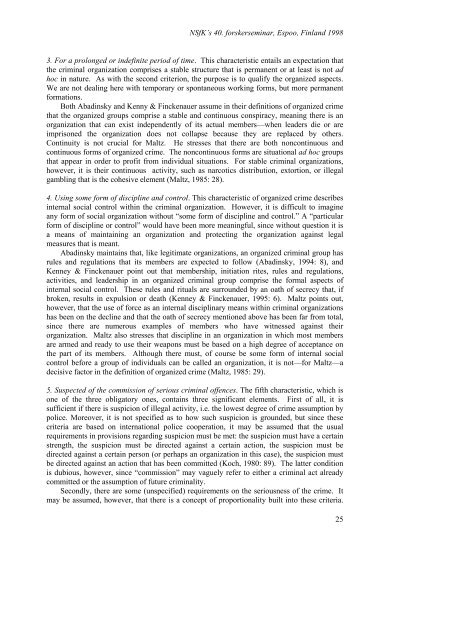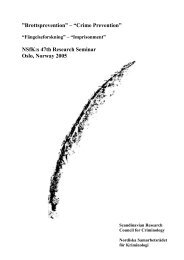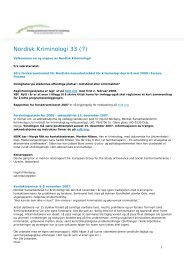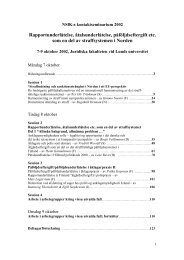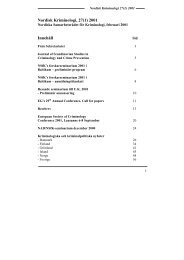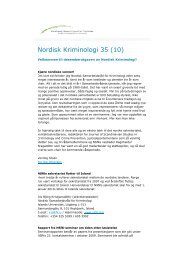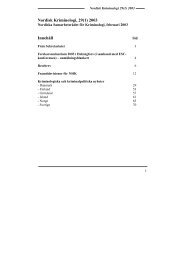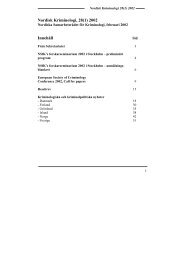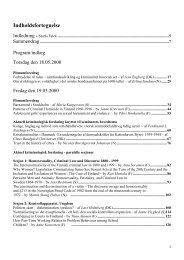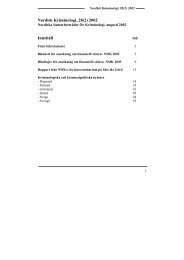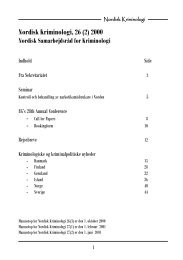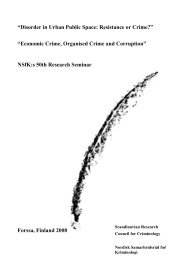Organised Crime & Crime Prevention - what works? - Scandinavian ...
Organised Crime & Crime Prevention - what works? - Scandinavian ...
Organised Crime & Crime Prevention - what works? - Scandinavian ...
You also want an ePaper? Increase the reach of your titles
YUMPU automatically turns print PDFs into web optimized ePapers that Google loves.
NSfK’s 40. forskerseminar, Espoo, Finland 1998<br />
3. For a prolonged or indefinite period of time. This characteristic entails an expectation that<br />
the criminal organization comprises a stable structure that is permanent or at least is not ad<br />
hoc in nature. As with the second criterion, the purpose is to qualify the organized aspects.<br />
We are not dealing here with temporary or spontaneous working forms, but more permanent<br />
formations.<br />
Both Abadinsky and Kenny & Finckenauer assume in their definitions of organized crime<br />
that the organized groups comprise a stable and continuous conspiracy, meaning there is an<br />
organization that can exist independently of its actual members—when leaders die or are<br />
imprisoned the organization does not collapse because they are replaced by others.<br />
Continuity is not crucial for Maltz. He stresses that there are both noncontinuous and<br />
continuous forms of organized crime. The noncontinuous forms are situational ad hoc groups<br />
that appear in order to profit from individual situations. For stable criminal organizations,<br />
however, it is their continuous activity, such as narcotics distribution, extortion, or illegal<br />
gambling that is the cohesive element (Maltz, 1985: 28).<br />
4. Using some form of discipline and control. This characteristic of organized crime describes<br />
internal social control within the criminal organization. However, it is difficult to imagine<br />
any form of social organization without “some form of discipline and control.” A “particular<br />
form of discipline or control” would have been more meaningful, since without question it is<br />
a means of maintaining an organization and protecting the organization against legal<br />
measures that is meant.<br />
Abadinsky maintains that, like legitimate organizations, an organized criminal group has<br />
rules and regulations that its members are expected to follow (Abadinsky, 1994: 8), and<br />
Kenney & Finckenauer point out that membership, initiation rites, rules and regulations,<br />
activities, and leadership in an organized criminal group comprise the formal aspects of<br />
internal social control. These rules and rituals are surrounded by an oath of secrecy that, if<br />
broken, results in expulsion or death (Kenney & Finckenauer, 1995: 6). Maltz points out,<br />
however, that the use of force as an internal disciplinary means within criminal organizations<br />
has been on the decline and that the oath of secrecy mentioned above has been far from total,<br />
since there are numerous examples of members who have witnessed against their<br />
organization. Maltz also stresses that discipline in an organization in which most members<br />
are armed and ready to use their weapons must be based on a high degree of acceptance on<br />
the part of its members. Although there must, of course be some form of internal social<br />
control before a group of individuals can be called an organization, it is not—for Maltz—a<br />
decisive factor in the definition of organized crime (Maltz, 1985: 29).<br />
5. Suspected of the commission of serious criminal offences. The fifth characteristic, which is<br />
one of the three obligatory ones, contains three significant elements. First of all, it is<br />
sufficient if there is suspicion of illegal activity, i.e. the lowest degree of crime assumption by<br />
police. Moreover, it is not specified as to how such suspicion is grounded, but since these<br />
criteria are based on international police cooperation, it may be assumed that the usual<br />
requirements in provisions regarding suspicion must be met: the suspicion must have a certain<br />
strength, the suspicion must be directed against a certain action, the suspicion must be<br />
directed against a certain person (or perhaps an organization in this case), the suspicion must<br />
be directed against an action that has been committed (Koch, 1980: 89). The latter condition<br />
is dubious, however, since “commission” may vaguely refer to either a criminal act already<br />
committed or the assumption of future criminality.<br />
Secondly, there are some (unspecified) requirements on the seriousness of the crime. It<br />
may be assumed, however, that there is a concept of proportionality built into these criteria.<br />
25


